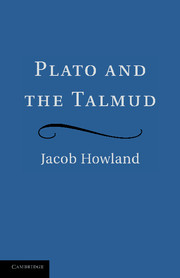Book contents
- Frontmatter
- Contents
- Acknowledgments
- Introduction: Athens and Jerusalem
- 1 Talmudic and Platonic Writing
- 2 Rabbis and Holy Men
- 3 Prophets and Philosophers
- 4 Fathers and Sons
- 5 Words and Deeds
- 6 Gods and Men
- 7 Miracles and Necessity
- Epilogue: Texts and Traditions
- Works Cited
- Index to Biblical and Rabbinic Texts
- General Index
1 - Talmudic and Platonic Writing
Published online by Cambridge University Press: 10 November 2010
- Frontmatter
- Contents
- Acknowledgments
- Introduction: Athens and Jerusalem
- 1 Talmudic and Platonic Writing
- 2 Rabbis and Holy Men
- 3 Prophets and Philosophers
- 4 Fathers and Sons
- 5 Words and Deeds
- 6 Gods and Men
- 7 Miracles and Necessity
- Epilogue: Texts and Traditions
- Works Cited
- Index to Biblical and Rabbinic Texts
- General Index
Summary
This book reads the aggadah of Ta'anit 3 alongside Plato's Euthyphro and Apology. A well-founded reading must begin by considering the nature of the texts at hand. The present chapter reflects on the literary characteristics of the Talmud and the Platonic dialogues with a view to establishing the fundamental interpretative assumptions of this study.
With regard to the Talmud, we must start by asking some basic questions. How do the Mishnah and the Gemara function as instruments of teaching and learning? What is the purpose of Talmudic aggadah? How does the aggadic material in the Talmud relate to its halakhic content? One way to address these questions is to inquire into the relationship between the literary genres of the Talmud and the earlier tradition of sacred writings. This approach leads us back to the origins of the Jewish literary tradition in the Bible.
SCRIPTURE, MIDRASH AND MISHNAH FORMS, AND ORAL TORAH
It is important to state at the outset that the beliefs and practices of Judaism were initially formulated and transmitted as an oral tradition, retained in memory and passed down through successive generations over the centuries. At some point, essential parts of this tradition – starting with the Torah proper, the Pentateuch – began to be committed to writing, presumably as a response to a crisis that caused its bearers to lose confidence in their ability to maintain the tradition in a purely oral form.
- Type
- Chapter
- Information
- Plato and the Talmud , pp. 26 - 75Publisher: Cambridge University PressPrint publication year: 2010



